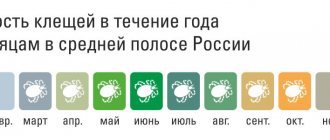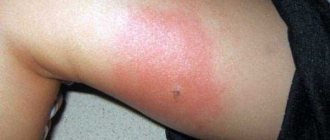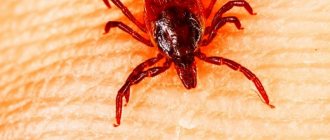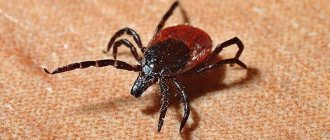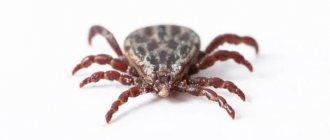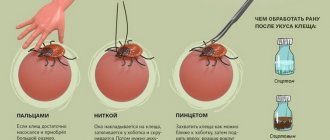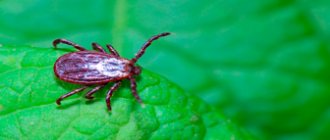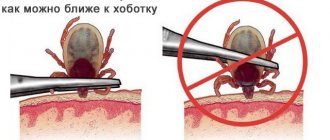Hello, dear readers! A few days ago, my husband returned from a hiking trip and told a scary story, which prompted me to write this post. My family and I live in the Rostov region and very often my husband goes with a camera “to get new shots.” Last year, in May, one of the trophies was a tick bite, which we survived with a certain amount of hysteria.
According to Rospotrebnadzor, by May 5, 2022, 31 thousand people sought medical help for tick bites - this is 1.8 times less than last year.
This time there have been no bites so far, but the prospect that arose on the last trip is, let’s say, promising. Throughout the entire hike, all he and his friend did was remove ticks from their clothes and shake off their boots. And at night, in the tent, they found a pair of bloodsuckers right under the sleeping bag. After reading a bunch of literature, I created a summary of the main points that you need to know if you or someone close to you is at risk and may be bitten by a tick.
Types of ticks. Which ticks are dangerous?
Today, science knows more than 48 thousand species of ticks. Can you imagine?! Most of them have not been studied and every year scientists discover new groups. We are interested in ixodes ticks (Ixodes), because... two representatives of this family pose a direct threat to humans - Ixodes persulcatus (taiga tick) and Ixodes ricinus (dog or European forest tick). So not all bloodsuckers are carriers of terrible infections, and if you find an unwanted guest on your body, you should not immediately faint. Moreover, even if the tick is infected, the probability of disease is not one hundred percent.
Tick activity
I dug up a picture on the Internet that very well illustrates the period of tick activity by month:
The first ticks wake up at 6-8 degrees Celsius, and hibernate at the first frost. You need to know: tick activity is high both in spring and summer. As soon as the sun warms the earth and greenery appears, we immediately remember about ticks and turn on increased vigilance.
What does a tick look like (photo)
The taiga tick lives in the Asian and several regions of the European part of our country. His brother in arms, Ixodes ricinus, is more likely to be encountered by those who, like our family, settled in the south of Russia. Here is a comparative photo of all varieties of this specimen:
Ixodes Ricinus .
Male, nymph, female and tick larva. I showed my husband the photo, he said that he more often removed males from his trousers than females. I was also surprised why some mites are black, while others have a reddish tint. All ticks of this species have a powerful shell and four pairs of legs. The reddish tint of the female is due to the fact that the integument of the back part is capable of greatly stretching and absorbing hundreds of times more blood than the weight of a hungry tick.
Here is such a cute female of the genus Ixodes
To our great happiness, we did not meet a female that had drunk blood, but I will also show you a photo. For comparison and greater ostracism. God forbid you encounter something like this:
Female ticks feed for 6 to 10 days. Now let's look at the male. It is smaller and not as bloodthirsty as its “weak” half - it sticks for a short time (less than an hour). Look carefully at these photos and remember what the male and female Ixodes ricinus look like. They don’t have eyes, but they have a very strong sense of smell: they can smell prey ten meters away.
By the way, if you were bitten by a male and you didn’t notice him right away, the situation may become more complicated. After drinking blood, the tick falls off and you are rewarded with a reddened spot on the skin, the origin of which you can only guess. If you do not find out in time the nature of this stain, you risk finding yourself in a dangerous situation.
Where do ticks live?
Ixodid ticks love moist and shaded areas. Most often they live in ravines, on forest edges, and on the sides of forest paths. At the moment, we need to remember about the danger even when going for a walk in a city park. Many of my friends argued and claimed that ticks jump from trees. They don't jump at all! It has been scientifically proven that ticks do not rise above 1.5 meters. In anticipation of prey, they climb onto grass stems and bush trunks and wait, and then grab with their paws anything that moves. Ticks can crawl over the body for some time and end up on the head, which is how the erroneous opinion arose that ticks live on trees.
What can you get infected with?
Of the extensive list of infections carried by these creatures, encephalitis leads. This disease is aimed at damaging the human nervous system (possibly death, disability, severe pain). Borreliosis usually causes damage to the nervous and motor systems. Often affects the heart and blood vessels (possible disability). Fever and other infections - timely detection and treatment will help completely avoid negative consequences.
It is important to remember that you need to take precautions, if you still need to go to places where these parasites are concentrated, you need to dress to the maximum without leaving any exposed areas on yourself. This way, the tick will not immediately get on your skin and, most likely, you will shake it off on the ground yourself.
Ticks on dogs and cats
A very important point that I would not want to miss when writing my notes is the presence of ticks in pets. Owners of dogs and cats are at particular risk in the summer. If your pet does not live permanently in an apartment, be prepared to have to deal with this problem closely. I will not describe what diseases a tick causes in a dog, just like a tick in a cat. I will also not show scary photographs of poor animals bitten by ticks. Just remember - you should know that through our little brothers you can get a bunch of unpleasant surprises.
Diseases transmitted by ticks
The complete development cycle of the parasite requires three times the consumption of the host's blood. Thanks to this, parasites are carriers of several dozen different pathogens that cause serious diseases in animals and humans:
- Lyme disease;
- encephalitis;
- anaplasmosis/erlichiosis;
- babesiosis
Other diseases that are usually transmitted by parasites:
- American fever;
- tularemia;
- cytauxoonosis;
- bartonellosis;
- toxoplasmosis;
- mycoplasmosis.
What does a tick bite look like (photo)
The area around the bite may be pink or red, depending on the body's reaction. A depression will be visible in the center. My husband was bitten by a tick early in the morning when he climbed into the grass to photograph a dragonfly. Usually, Andrey (that’s my husband’s name) tucked his jeans into his socks if he wasn’t wearing combat boots. That morning I hoped for hope. It was lucky that he noticed the “beast” quickly and pulled it out without any problems.
A red spot formed on my husband’s leg after a tick bite. He immediately circled it with a pen, for control, because... If the redness increases, I would have to consult a doctor again. If you don’t have a pen, be sure to take a photo of the bite site with your phone.
If you look closely at the previous photos of ixodid ticks, you will see the proboscis with which they pierce the human skin. This thing is called a hypostome. With its help, the tick not only sucks blood, but also “sniffs out” the victim. Typically, an attached parasite is found in this state:
After it pierces the skin, it is immediately attached inside the wound with the help of special saliva, which both anesthetizes and secures the proboscis in the wound. This is why a person does not feel the moment of the bite.
Where and when are you most likely to get bitten?
People living in disease-endemic areas, as well as those who visit these areas during periods of particular tick activity - from May to mid-June and from late August to late September - are most at risk of contracting a serious illness from a tick bite.
But the danger of being attacked by ticks remains throughout the warm period of the year when visiting almost any forested areas, parks and other areas where there is grass and shady shelters. You can even get a tick bite in your dacha or in the local area of your private home, if the grass there is not mowed.
The maximum number of bites from infected ticks is recorded annually in Siberia, the Urals and the Volga region. However, a considerable number of those bitten annually seek medical help in almost all regions of Russia, including Crimea and the Caucasus.
Symptoms of a tick bite
Under the influence of tick saliva and microtrauma, round redness may appear on the skin of a bitten person. Sometimes, if a person is prone to allergies, angioedema or anaphylactic shock occurs. The most common symptoms that can be noticed 2-3 hours after being bitten by a tick:
- redness of the bite site;
- weakness, drowsiness;
- chills;
- aching joints;
- photophobia.
But in general, everything is individual, and depends, to a greater extent, on your physical condition. In healthy adults, everything goes unnoticed until they discover a tick on themselves. Changes that may occur later: fever, enlarged lymph nodes, headaches or muscle pain, rash on the body. Different tick-borne infections have different symptoms, so signs will appear a few days to two weeks after infection. By the way, it is impossible to distinguish a seemingly healthy tick from an infected one, and the longer it sucks blood, the higher the risk of infection.
Treatment
Treatment always depends on what disease struck the person bitten and how long it progressed before the person consulted a doctor and was diagnosed.
How are tick-borne diseases treated?
Once the diagnosis is made, treatment is prescribed by the doctor. In the absence of severe symptoms, medications are taken at home, but if the disease is severe, the patient is sent to a hospital.
Most tick-borne infections can be cured with antibiotics, with the exception of encephalitis, the most severe disease that a tick can transmit. There is no targeted therapy against tick-borne viral encephalitis yet. Supporting agents include: medications containing interferon and interferon inducers, drugs to remove toxins from the body, antipyretics, and anti-inflammatory drugs.
On our website you can learn more about the course and treatment of tick-borne encephalitis, borreliosis and tularemia.
Are they completely cured?
Tick-borne diseases can be cured, but some of their consequences, such as permanent paralysis or hearing loss caused by encephalitis, remain irreversible. Muscle pain and manifestations of arthritis after suffering from borreliosis may remain for a long time after treatment.
Chronic Lyme disease is referred to by some practitioners as post-Lyme disease syndrome. Although most patients with borreliosis can be cured with a 2-4 week course of antibiotics, some patients may continue to have symptoms (joint pain, fatigue, confusion) many years after the illness. This development of infection is usually associated with an autoimmune reaction of the body.
Source - article “Lyme disease or tick-borne borreliosis.”
How long does treatment take?
Antibiotic therapy aimed at eliminating the infection lasts about 7-14 days. The course of treatment for tick-borne encephalitis is usually 3-5 weeks. After discharge, survivors of encephalitis should be examined at intervals of 3-6 months for 1-3 years.
What should I do if bitten by a tick
Do not panic. I'm serious. Remember one simple rule: if you are bitten by a tick, DO NOT PANIC! If you can quickly get qualified help, go ahead! If not, everything in our lives sooner or later happens for the first time. With confident hands we remove the tick from the body. There are several ways to do this.
How to remove a tick
1. With your fingers. But not naked. Wrap them in a bandage, gauze, or use a sock. It is important to minimize tick contact with unprotected skin. Grasping the tick as close to its proboscis as possible, carefully unscrew it (like a screw) from the skin. It doesn’t matter which way you twist, the main thing is to keep it parallel to the bite site while removing it. 2. Use thread. Make a loop and place it around the base of the tick's sting. Gently tighten and unscrew the insect from the skin. Do everything calmly, without sudden movements. Usually 1-3 turns and the entire tick is removed along with the proboscis. 3. Use special tools such as tweezers, Klinver, Tick Nipper, lasso pen, etc. But you need to purchase them in advance at a pharmacy or tourist store.
Of the above methods, the last one is the most effective, and the first one is the most risky. I won’t describe the crazy methods, but know that they exist: removing the tick with a syringe, creating a vacuum; smothering ticks with oil; use of soap, etc. No matter how you remove the tick, always remember - you cannot tear off the head. There are salivary glands, and in them all the evil of the world. If you still screw up and the sting remains in the skin, then DON’T PANIC! Pour alcohol into the tick bite area, burn the needle, lubricate it with alcohol and carefully remove the remains from the wound, like a splinter.
I really liked the video on how to remove a tick with a thread, be sure to watch it:
Notice how calmly and quickly the father pulled this arachnid out of his son’s cheek. Well done, this is how you should behave when a child is bitten by a tick!
Where to store ticks
After all the manipulations done, you should have a reddened wound treated with alcohol (iodine, cologne), a live tick (preferably) and washed hands (since tick-borne encephalitis can be transmitted through the gastrointestinal tract). If the “little animal” is alive, we place it in a test tube, vial, or any jar with access to air. My husband wrapped it in a napkin until he got to the pharmacy. There I bought a syringe with a needle, broke off the tip, and placed the tick inside. In this state, Andrei had a chance to keep the insect alive for two days; it was during this period that the tick should be taken to a special laboratory where research is carried out on infection with tick-borne encephalitis viruses. To be completely sure that your new friend will not die before the analysis, you can place him in a clean container (test tube, jar, vial) on a piece of damp gauze, close it tightly and place it on the bottom shelf of the refrigerator. Take it to the laboratory as soon as possible. If the tick is dead, it needs to be burned or poured with boiling water, because Dead specimens are useless for research.
Where to submit a tick
The tick must be taken alive to a special laboratory. If an infection is detected in the laboratory, the patient is given anti-mite immunoglobulin. This type of treatment is called “emergency seroprophylaxis” and is relevant in the first three days after infection. If it is not possible to use immunoglobulin, then antiviral drugs may be prescribed.
Speaking of “special laboratories”. My husband, after going to the emergency department, received the following recommendations: we will take the tick, we will hand it over to the SES, and you will go straight to the emergency room. As it turned out later, there are no laboratories in our city. A week later we called the sanitary and epidemiological station, gave the name and wanted to know the result. The answer was: we don’t do analyses, we need the tick for statistics. So keep in mind that in order to get an analysis for the presence of diseases in your bloodsucker, take it to the laboratory, if there is one, of course, and do not give it to an emergency doctor.
The story with the emergency room is also interesting. The doctor immediately said: “Did you pull it out? What did he come to me? After 10 days the temperature does not rise - everything is fine, but if it rises - then come back.” This is science for those who read this post - engage in educational programs and arm yourself with knowledge. So to speak, help yourself: 10 days after the bite we donate blood for borreliosis and encephalitis. Research method - PCR. After 2 weeks - for immunoglobulins M for encephalitis, after 3 weeks - for immunoglobulins M for borreliosis. With the test results (positive), we go to the doctor. We’re not even walking, we’re flying like a “bullet,” because... the same borreliosis can be treated very well if dealt with in the early stages.
Vaccination against tick-borne encephalitis
There are currently several vaccine preparations against tick-borne encephalitis on the market. For example, EnceVir (EnceVir) made in Russia, or Encepur (Germany) , which is produced for both adults and children.
Every major city has laboratories involved in the research of tick-borne viruses and preventive medical clinics. At this link you will find the addresses of such medical institutions in different cities and regions of the Russian Federation.
At the end of the article, I would like to repeat the common truth - if you are bitten by a tick, immediately go to the nearest hospital . This is not an empty call, it is a recommendation that can save your life. And don't forget about preventive methods of protection. After all, if there is no tick bite, there will be no consequences .
Post Views: 3,335
What diseases do ticks carry?
Ticks transmit a lot of different nasty things. But among other things, I will highlight the main ones:
- Tick-borne borreliosis (Lyme disease)
- Tick-borne viral encephalitis
- Tick-borne typhus
- Hemorrhagic fever
In addition to those above, which are more or less well-known, there are also babesiosis, rickettsiosis, granucytic anaplasmosis, monocytic ehrlichiosis and other difficult-to-pronounce infections. The causative agents of all this nasty stuff (arboviruses) live in the saliva of the tick, but not in everyone and not in a complete set. So there is a risk of disease, but not 100%. The biggest chances (and worst) are encephalitis and borreliosis (Lyme disease).
Encephalitis
Tick-borne encephalitis leads to inflammation of the brain. No matter how cynical it may sound, but in an excellent situation you will get off with a slight fright, in a good situation you will die. But most likely you will be paralyzed. Most likely hands, or one of them. This is forever and cannot be repaired. In addition, you may become blind and/or deaf. If you are bitten by a tick in European regions, it will most likely be okay. In our country, ticks are not particularly infected - according to various sources, from a few percent to a few tenths of a percent, and 2 out of 1000 people die from tick-borne encephalitis. THIS DOES NOT MEAN THAT YOU WILL BE LUCKY. If you are bitten by a tick in Siberia or the Far East, everything is much worse. You may get Far Eastern encephalitis, and out of 100 people who get sick, 80 die from it.
The presence of encephalitis can be determined only after 10 days by donating blood for testing using the PCR method. The disease itself begins acutely, accompanied by chills, severe headache, a sharp rise in temperature to 38-39 degrees, nausea, and vomiting. Worrying muscle pain, which is most often localized in the neck and shoulders, thoracic and lumbar back, and limbs.
Borreliosis
It all starts with a high temperature and these beautiful rings at the site where the tick bite was discovered (scientifically called erythema).
Then paralysis, only this time the problems were not with the arms, but with the face. Then problems with the joints (for example, severe pain in them, to such an extent that it is impossible to move), with the heart, vision, hearing. Then the skin becomes thinner, becomes dry like parchment paper and develops bluish spots. In general, there are a lot of problems, and everyone is so different. Some citizens suffering from chronic borreliosis claim that it is worse than encephalitis. True, they assure healthy people, not those with chronic encephalitis. An important point that you should remember when encountering ticks: you can get the disease not only through an insect bite. Infection can occur when a tick is crushed at the time of removal from the body of an animal or person, if the mucous membrane of the eyes, nose, lips or damaged areas of the body is touched with unwashed hands. You don’t have to go hiking yourself, but simply host friends at home who will bring ticks with them on their clothes. I know of a case where a tick was brought into a house with wildflowers. You can also get a “gift” by eating raw milk from goats, sheep or cows, whose milk contains the virus during a mass tick attack. Moreover, not only milk will be contagious, but also products made from it: cottage cheese, sour cream, etc.
If you have encephalitis/borreliosis, it is not contagious to others - you can sneeze on them as much as you want. But if you have encephalitis and you are a nursing mother, there is a chance you can pass it on to your baby through your milk.
Morphology
The body of mites (arachnids) consists of segments, and the easiest way to see such segments is in scorpions, which also belong to the above class. The creature's body consists of two segments.
- The head is a gnathosoma, consisting of mouthparts.
- The body is an idiosoma, 4 pairs of legs grow from it.
This is a generalized diagram that gives some idea of the structure of the tick, the body of which biologists divide into several subsegments.
Head and torso
The small head of the insect, the size of which is less than 30% of the body size, can move and even be retracted into the body.
Head composition
- 2 upper jaws, similar to claws, are mandibles.
- Hypostome - this proboscis evolved into an oral apparatus from previously existing tentacles.
The mandibles work like knives, cutting the skin of the victim, then the hypostome is pierced into the hole, it penetrates inside and, like a harpoon, with sharpened teeth holds the tick on the victim.
What is the most effective tick repellent?
First of all, it is proper preparation and control of the situation. When traveling to an area with an increased risk of encountering ticks, you should be vaccinated against tick-borne viral encephalitis. It is a three-stage procedure; they will inject three times at a certain interval. If you have already had encephalitis, then you are immune. Several vaccines against encephalitis are registered in Russia. If you have a choice, take an imported vaccine. The vaccination can be done in the vaccination office at the clinic after consulting a doctor. AND DON'T GIVE IN TO DIVORCE, at the same time get vaccinated against hepatitis, flu, the devil in a mortar. Vaccinations are not an area where wholesale is a profitable business. It is impossible to vaccinate against borreliosis. And here, if you have already been sick, nothing prevents you from catching it again.
Important! It is necessary to complete the entire vaccination course against tick-borne encephalitis 2 weeks before leaving for a disadvantaged area.
Anti-tick clothing
We choose smooth, light-colored clothing that minimizes the possibility of ticks crawling under it. Smooth - to make it harder to get caught, light - to make it easier to see the dangerous “fellow traveler”. Our friend persistently tried to somehow prove that ticks cling more readily to white and light-colored fabric. So, this is fiction!
The visual apparatus of ticks does not allow them to distinguish colors, but their sense of smell is so developed that they are able to smell a person 10 meters away.
Next, we tuck everything above the waist (T-shirt, jacket, sweater) into the trousers. We tuck the trousers into berets and boots. If you don’t have high shoes, just put them in your socks, it looks funny, but it saves you the best! The sleeves should have tight-fitting cuffs; if not, then we sew in an elastic band or tuck them into gloves. On our head we have a good cap that protects our hair and neck, or a hood, or at worst a scarf, the ends of which should be tucked under the collar. A hat is a must!
Treating clothes against ticks
The most effective remedy for ticks is the frequency of inspection of your own body while traveling. But to be on the safe side, you can use tick repellents. Acaricidal treatment of the tissues covering you is necessary, but in my opinion it is a no-brainer, it wears off quickly, so it ends quickly. But a good tick repellent is not cheap. But there is also a budget option: essential oil. Having sifted through a bunch of information about this summer scourge, I came to the conclusion that essential oil is a very effective remedy for ticks. So before going on a hike, dilute the oil with water and spray it on yourself. You can also lubricate your hands and neck.
- Lavender – the amazing thing is that we love the smell of lavender, but ticks can’t stand it. Moreover, this also applies to midges and mosquitoes.
- Pennyroyal – This essential oil is toxic to insects and is an effective natural repellent!
- Schisandra – Schisandra oil is obtained from the tropical Schisandra plant known as “Cymbopogon”. It has a bright citrus scent and is a natural flea and tick repellent.
- Eucalyptus – Eucalyptus oil can be used alone or in combination with lemongrass oil to deter any insects.
- Lemon – Lemon essential oil contains a compound known as “limolene”. This mixture is considered especially effective in the fight against fleas and other insects.
You will smell it a mile away, repelling not only ticks, but also giving pleasure to your travel companions.
Sightseeing during the hike
Returning to where we started. The most effective remedy for ticks is frequent and careful inspection of clothing. My husband forced everyone to stop and look at each other every hour. It was almost always justified! It usually takes the tick half an hour to reach the soft tissues and insert its sting into your delicate skin. Therefore, the more often you inspect clothes, the less likely he is to do so. When you return home with a light heart, once again inspect all your clothes and all your camping equipment. Every fold and every seam. Run a sticky roller over dark clothing to catch anything your eye might have missed.
In the bathroom, examine your body, even its most hidden parts. Remember: favorite places for ticks: behind the ears, on the neck or stomach, in the groin, under the arms, on the inside of the elbows and knees. The size of a tick that is not engorged with blood is 1–3 mm, and that of a engorged tick is up to 1 cm.
Now let’s read like a mantra the main points you need to know:
- Not all ticks are carriers of infectious diseases
- If you are bitten by a tick, it’s okay, the main thing is not to panic
- Ticks don't fall from trees
- The color of clothing does not matter; ticks do not see, but react to the smell
- Always tuck your pants into your socks
- The main protection against ticks is proper clothing and vigilance
- The tick vaccine is effective one month after vaccination
- There is no need to kill the bitten tick; it is needed alive for testing
- It is recommended to destroy ticks by fire.
- The tick must be submitted to the laboratory within two days after the bite.
- Blood must be donated for PCR testing
- The most terrible diseases caused by a tick bite make themselves felt within a week
Wish you luck! Take care of yourself and your loved ones! Mom Inga.
